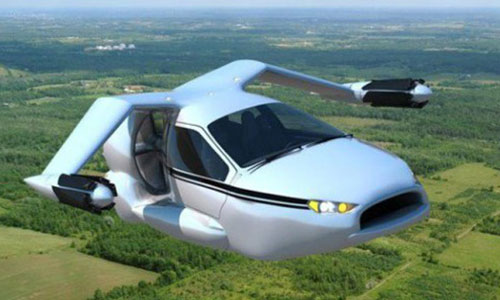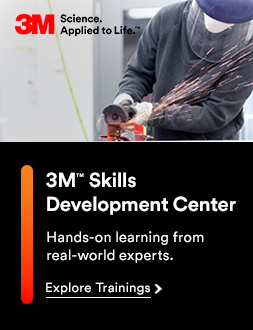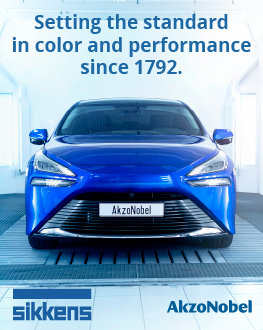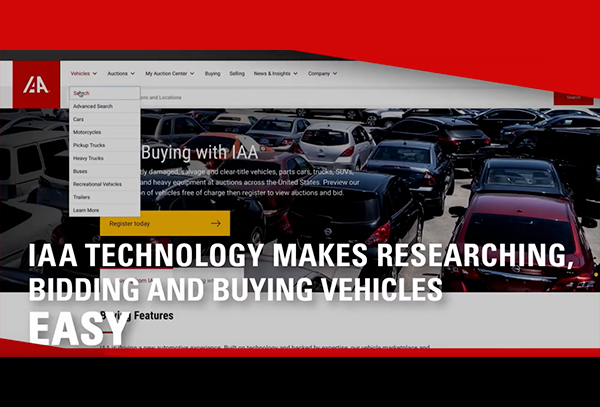By Jeff Sanford
Toronto, Ontario — November 13th, 2017 — In this week’s Autonomous Report, we look at BMW’s path towards AV technology, Uber’s partnering with NASA on flying taxis and much, much more!
-A flurry of news reports appeared this week about a new driverless shuttle bus that crashed less than two hours after it was launched in Las Vegas on Wednesday. It seems humans love to see the robots screw up. According to one report, “The city’s officials had been hosting an unveiling ceremony for the bus, described as the US’ first self-driving shuttle pilot project geared towards the public, before it crashed with a semi-truck.” It seems however, that the AV was not at fault. According to the Las Vegas Review-Journal, “… the human driver of the other vehicle was at fault, there were no injuries, and the incident caused minor damage.” An attendant on the bus later popped up on Reddit to say the same thing. “The oval-shaped shuttle — sponsored by AAA — can transport up to 12 passengers at a time. It has an attendant and a computer monitor, and uses GPS and electric curb sensors instead of brake pedals or a steering wheel, according to a report.
-A BMW blog has revealed some of the German automaker’s plans regarding AVs. Apparently, self-driving capabilities will be optional. BMW is in a tough position when it comes to AV technology. According to tech website arstechnica.com, “BMW is a brand that prides itself with the driving pleasure offered by its cars, but it can’t go against the tide when it comes to autonomous technology.” BMW previously announced it would release its first fully autonomous car in 2021. The carmaker is taking its time with the project because it, “… believes a more cautious approach will pay off when it comes to the functionality of the final product.”
BMW included a chart on its blog describing the way the automaker is defining the different levels of autonomous driving. Many have talked about the five steps toward fully autonomous driving. This is how BMW designers are thinking about those steps:
ο Level 0 – Hands on, Eyes on
ο Level 1 – Hands on, Eyes on, longitudinal or lateral guidance
ο Level 2 – Hands temporary off, eyes temporary off, traffic control and longitudinal or lateral guidance
ο Level 3 – Hands off, eyes off, awareness for take over, take over request
ο Level 4 – Hands off, mind off, no driver intervention, no take-over request
ο Level 5 – Hands off, driver off, no driver
The BMW coming in 2021 will be Level 3. But the self-driving feature won’t be standard. BMW has made the driving performance of its cars the core of its brand. It is not going to get rid of that legacy any time soon. Dr. Klauss Buettner, head of autonomous driving at BMW, said on the blog, “There is a contradiction in brand values between manual driving and autonomous driving. How to deal with both expectations?” Self-driving technology will be an option and will cost extra.
Audi has already announced that it is coming to market with a Level 3 AV next year. The Audi A8 will be able to drive itself at speeds under 60 km/h. The BMW cars will allow self-driving at speeds up to 129 km/h. That is, the coming BMW Level 3 AV will be able to self-drive on highways. To ensure the car is safe the company has set a goal: 240 million kilometers of testing without accidents have to be completed before it will be released. The company made a point of saying it would not do “beta” testing on customers (as Tesla has done). The company is testing 40 BMW AVs around Munich. That program will expand to hundreds of cars over the next two years.
-New data suggests what many have assumed: Ride sharing services like, “Uber, Lyft, and other app-based ride services are unequivocally worsening gridlock in the Manhattan core as well as northern Manhattan and the western parts of Queens and Brooklyn… “ This is according to a report released recently by a transportation analyst. It found that the arrival of the ride-sharing services, “… caused a net increase of 600 million vehicle miles traveled in the five boroughs — a 3 to 4 percent jump in citywide traffic… This trend marks a troubling inflection point — for the first time in many years, car-based services, not transit, account for most growth in travel.” This is very interesting. Toronto Transit Commission executives were shocked recently when expected increases in ridership did not occur as predicted. TTC use levelled off, rather than expanding as might be expected in a city where the population is growing rapidly.
This study seems to suggest that the levelling off in the use of the TTC is, at least, partly a result of the increase in the use of ride-sharing services. Many have speculated that “total miles driven” would rise as more people used these applications. They make travelling by car much cheaper. It shouldn’t be a surprise then that many more cars are driving more miles now. Many people have taken up “driving Uber” as a second job in the GTA. According to the study, “In 2013, the last year before Uber’s presence was felt, use of subways, buses, and bicycles grew substantially. But by 2016, net growth in travel by Uber and other TNC’s far outstripped growth in those modes.”
The consultant who carried out the study also, “… identifies growth in use of TNC’s as a prime cause of the 11 percent slowing of traffic in Manhattan from 2013 to 2016…” As well, “In a marked reversal from the transit-oriented growth that lasted from 1990 to 2014, growth in for-hire vehicle use (TNC’s, yellows, greens, and all car services combined) is outstripping growth in transit ridership, making it the city’s leading source of growth in non-auto travel.” The consultant believes these trends are, “… virtually certain to continue… fuelled not just by the convenience, dependability, and cachet of Uber and other TNC’s, but by their low fares. Traditionally, a ride in a taxicab was four to five times as expensive as a subway or bus ride, which acted as a brake on usage. Now, however, TNC fare offerings for shared trips during rush hour in Manhattan put TNC fares at less than twice the transit fare, dramatically weakening the disincentive to travel by auto.” The consultant concluded by saying, the resulting “reversal from transit-led to TNC-led growth in travel, will have profound implications for the city’s transportation network if current trends continue.”
-A story in the magazine Reason discusses how regulations around auto production will change in the coming era of AVs. According to the feature, “Federal auto safety regulations fill nearly 900 pages … everything from rear-view mirror positioning to steering wheel placement is regulated … many of the rules don’t make sense in the coming era of self-driving cars,” according to the story. “Autonomous vehicles don’t need rear-view mirrors, or (eventually) steering wheels. Their ideal physical form is still a work in progress… But an even bigger rethink is in order.
As motor vehicles become essentially computers on wheels, software, not hardware, will soon be paramount for safety. This will make most government regulation unnecessary…” According to the story, “One difference between self-driving cars and traditional automobiles is that companies will have every incentive to fix safety problems immediately. With today’s cars, that hasn’t always been the case.
The story goes on to site the example of General Motors and its 2014 recall of 800,000 cars with faulty ignition switches. The company knew about the safety flaw over a decade prior, but didn’t act on the information because recalls are so costly. The company’s actions had dire consequences: One-hundred-and-twenty-four deaths were linked to the ignition defect. But the safety problems of the future will primarily be bugs in software not hardware, so they’ll be fixed by sending ones and zeros over the Internet without the need for customers to return hundreds of thousands of vehicles to the manufacturer.
A source quoted in the story says, “Replacing software is free… so there’s no reason to hold back on fixing something.”
As well, regulators will find it difficult to discover how the systems work. According to the story, “… when hardware was all that mattered for safety, regulators could inspect a car and determine if it met safety standards. With software, scrutiny of this sort may be impossible because the leading self-driving car companies (including Waymo and Tesla) are developing their systems through a process called machine learning… Machine learning is developed organically, so humans have limited understanding of how the system actually works. And that makes governments nervous.” The writer notes that, “Regulations passed by the European Union last year ban so-called unknowable artificial intelligence.” In contrast to the European approach, the source says, “If it turns out that [machine learning systems] do a better job [on safety] but we don’t know why, we’ll be in a situation of deliberately deploying the thing that’s worse because we feel a little more comfortable that we understand it.”
As it is, the alternative to allowing imperfect self-driving cars on the highways is the status quo — 100 Americans die every day in automobile crashes. And that suggests that even if AVs are imperfect (but still better than humans at driving) they should be let on the road. As another source is quoted as saying, “That these need to be perfect before we can allow them on the road is a mindset that has affected a lot of urban planners and the pro-regulation set. [But] delaying self-driving car technology means we’re going to see additional deaths that we simply could have avoided if we allowed these vehicles on the road that are not perfectly safe but safer than the cars we have today.
-Another flurry of articles appeared when it was announced that Uber is taking part in a joint industry and government push with NASA to develop software, which the company aims to use to manage “flying taxi” routes.
According to one of the media reports, “Uber said on Wednesday it was the first formal service contract by the U.S. National Aeronautical and Space Administration (NASA) covering low-altitude airspace rather than outer space. NASA has used such contracts to develop rockets since the late 1950s… Chief Product Officer Jeff Holden also said Uber would begin testing proposed four-passenger, 200-miles-per-hour (322-km-per-hour) flying taxi services across Los Angeles in 2020, its second planned test market after Dallas/Fort Worth.”
In a press release NASA said it had signed a “generic agreement in January with Uber that enables the company to join a variety of industry partners working with NASA to develop a range of driverless air traffic management systems… That deal calls for Uber to be involved during phase 4 of this work, which is scheduled to begin in March 2019, NASA said.” According to the story, “Phase 1, completed in 2015, involved field tests and ongoing testing at a U.S. Federal Aviation Administration (FAA) site for drones used in agriculture, fire-fighting and pipeline monitoring, NASA has said. Phase 2 in 2016 considered long distance uses in sparsely populated regions, while Phase 3 in 2018 will test services over moderately populated areas, leading to Phase 4 testing in high-density urban areas in 2019.”
According to the story, Uber is looking to speed development of a new industry of electric, on-demand, urban air taxis, “which customers could order up via smartphone in ways that parallel the ground-based taxi alternatives… “ Uber has hired two former NASA vets to run its aircraft vehicle design team and air traffic management software program. The story notes that the agreement with NASA aims to solve issues involved in operating hundreds or even thousands of driverless aircrafts over urban areas and allow them to co-exist with existing air traffic control systems as well as in and around busy airports… Uber envisions a fleet of electric jet-powered vehicles — part helicopter, part drone and part fixed-wing aircraft — running multiple small rotors capable of both vertical take off and landing and rapid horizontal flight… Uber is working with manufacturers including Aurora Flight Sciences, which was acquired by Boeing last month… It has also signed up Embraer, Mooney, Bell Helicopter, and Pipistrel Aircraft to develop new vertical take-off and landing aircraft for the service.”







































